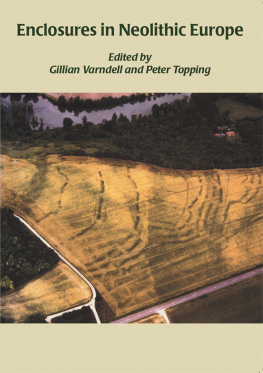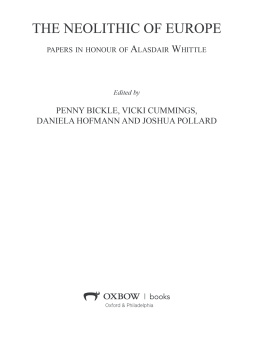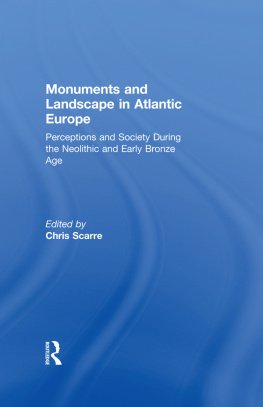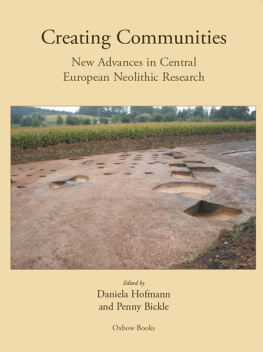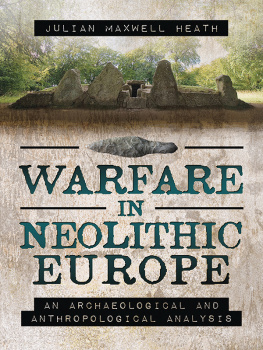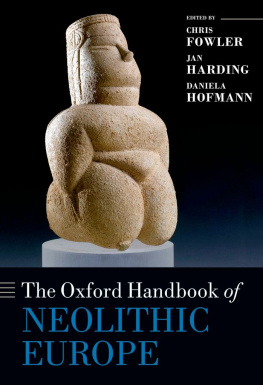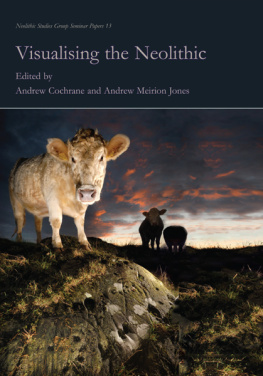G. Varndell - Enclosures in Neolithic Europe
Here you can read online G. Varndell - Enclosures in Neolithic Europe full text of the book (entire story) in english for free. Download pdf and epub, get meaning, cover and reviews about this ebook. year: 2017, publisher: Casemate Publishers & Book Distributors, LLC, genre: Science fiction. Description of the work, (preface) as well as reviews are available. Best literature library LitArk.com created for fans of good reading and offers a wide selection of genres:
Romance novel
Science fiction
Adventure
Detective
Science
History
Home and family
Prose
Art
Politics
Computer
Non-fiction
Religion
Business
Children
Humor
Choose a favorite category and find really read worthwhile books. Enjoy immersion in the world of imagination, feel the emotions of the characters or learn something new for yourself, make an fascinating discovery.
- Book:Enclosures in Neolithic Europe
- Author:
- Publisher:Casemate Publishers & Book Distributors, LLC
- Genre:
- Year:2017
- Rating:3 / 5
- Favourites:Add to favourites
- Your mark:
- 60
- 1
- 2
- 3
- 4
- 5
Enclosures in Neolithic Europe: summary, description and annotation
We offer to read an annotation, description, summary or preface (depends on what the author of the book "Enclosures in Neolithic Europe" wrote himself). If you haven't found the necessary information about the book — write in the comments, we will try to find it.
Enclosures in Neolithic Europe — read online for free the complete book (whole text) full work
Below is the text of the book, divided by pages. System saving the place of the last page read, allows you to conveniently read the book "Enclosures in Neolithic Europe" online for free, without having to search again every time where you left off. Put a bookmark, and you can go to the page where you finished reading at any time.
Font size:
Interval:
Bookmark:

Essays on Causewayed and Non-Causewayed Sites
Edited by
Gillian Varndell and Peter Topping

First published in the United Kingdom in 2002. Reprinted in 2017 by
OXBOW BOOKS
The Old Music Hall, 106-108 Cowley Road, Oxford OX4 1JE
and in the United States by
OXBOW BOOKS
1950 Lawrence Road, Havertown, PA 19083
Oxbow Books and the individual authors 2002
Paperback Edition: ISBN 978-1-84217-068-7
Digital Edition: ISBN 978-1-78570-523-6
Mobi Edition: ISBN 978-1-78570-524-3
A CIP record for this book is available from the British Library
All rights reserved. No part of this book may be reproduced or transmitted in any form or by any means, electronic or mechanical including photocopying, recording or by any information storage and retrieval system, without permission from the publisher in writing.
For a complete list of Oxbow titles, please contact:
UNITED KINGDOM
Oxbow Books
Telephone (01865) 241249, Fax (01865) 794449
Email:
www.oxbowbooks.com
UNITED STATES OF AMERICA
Oxbow Books
Telephone (800) 791-9354, Fax (610) 853-9146
Email:
www.casemateacademic.com/oxbow
Oxbow Books is part of the Casemate Group
Front cover: Overlooking a bend of the Charente, this site comprises a series of ditch-systems delimiting the promontory. BAPC no. 1928-A. Balzac (France), Les Coteaux de Coursac. Neolithic peron barr. Aerial survey and copyright of Jacques Dassi.
The papers presented here represent the proceedings of a conference held on the 23rd October 1999 in London entitled Neolithic Causewayed Enclosures in Europe . The conference was organised jointly by the Royal Commission on the Historical Monuments of England (RCHME; a part of English Heritage since April 1999) and the Prehistoric Society, with assistance from the Neolithic Studies Group.
The conference was designed to present an overview of recent work on causewayed enclosures in continental Europe (probably the first British review since the conference held in Newcastle in 1984) to complement an RCHME project which had systematically recorded all known Neolithic enclosures in England by both analytical topographic survey techniques and aerial transcription. The overall aim of the RCHME project was to produce a new national corpus of surveys to both assist management needs and inform the academic debate. This approach allowed the sites to not only be accurately recorded and interpreted but also considered in their individual, regional and national landscape contexts at a more detailed level than has previously been possible. The resulting data from this project has allowed a radical reinterpretation of themes such as the recognition of regional groups of enclosures, for example. During the course of the project a secondary focus developed which studied a representative sample of more unusual upland stone-built enclosures: the sites were chosen where morphology or other evidence suggested the possibility of a Neolithic context. This latter element of the project was intended to broaden the discussion about the structure and form of Neolithic enclosures beyond lowland England, and review the geographical range of causewayed monuments and what may have been their non-causewayed counterparts. Collaboration with sister organisations and individuals in Scotland (Strat Halliday and RCAHMS), Wales (Toby Driver and RCAHMW) and Ireland (Jim Mallory) provided complementary information from these countries.
During the preliminary organisation for the conference, it became clear from those who responded to the Call for Papers that the subjects being offered mirrored the evolution of the RCHME project. Not only were studies of causewayed enclosures sent for consideration, but also others that did not conform to the traditional site typologies but had been proven by excavation to have a Neolithic context. The conference programme included papers on the Tavoliere Plain in South-Eastern Italy from Skeates, La Hersonnais in Ille-et-Vilaine from Tinevez, West-Central France by Burnez and Louboutin, Scandinavia by Andersen, Central Europe from Braasch, Ireland by Cooney, and an overview of the RCHME project from Oswald (not included in these proceedings, see Oswald et al. 2001). One further paper from Saville broadened the debate by reviewing the lithic assemblages from causewayed enclosures in the UK. A number of complementary papers have been included in the proceedings which either increase the range of the volume or present evidence of newly discovered enclosures (contributions by Barfield, Brown, Butler, Darvill, Horne, MacLeod & Oswald, Pearson & Topping, and Vaquer).
Overall this volume of papers has a primarily European focus to complement the RCHME project volume and although sadly together they cannot claim to provide a comprehensive overview of the European evidence in its entirety, they do produce a series of snapshots of some of the sites and regions at the forefront of current research. It is to be hoped that the European archaeological community does not have to wait another 15 years before we see a further conference reviewing these enigmatic sites, particularly as new discoveries continue to increase their distribution into some of the previously blank areas of the continent such as the Netherlands and Eastern Europe (cf. Braasch this volume). It is clear that as a community within Europe we archaeologists need more such fora in which to discuss our research and progress our studies of common themes or site- types.
This volume has deliberately been edited with a light hand; where papers by contributors whose first language is not English are concerned the editors have tried to ensure clarity without sacrificing the individual voices of the authors.
Gillian Varndell and Peter Topping
London and Cambridge
November 2000
See Burgess, C., Topping, P., Mordant, C. & Maddison, M. 1988. Enclosures and Defences in the Neolithic of Western Europe. Oxford. British Archaeological Reports, International Series, 403.
Oswald, A., Dyer, C. & Barber, M. 2001. The Creation of Monuments: Neolithic Causewayed Enclosures in the British Isles. Swindon. English Heritage.
The organisers would like to thank the former RCHME and English Heritage and the Prehistoric Society for generously supporting the conference. The Neolithic Studies Group through their co-ordinators Tim Darvill and Gordon Barclay helped to promote the event and also deserve thanks.
The conference organisers would like to thank the venue, the Scientific Societies Lecture Theatre, New Burlington Place, London, and specifically the manager Mr Colin Powell, for their assistance during the planning of the event and helping to ensure that the conference proceeded smoothly. In addition, the assistance of anonymous referees from the Prehistoric Society was greatly appreciated during the preparation of these proceedings. To everyone involved go our sincere thanks.
Next pageFont size:
Interval:
Bookmark:
Similar books «Enclosures in Neolithic Europe»
Look at similar books to Enclosures in Neolithic Europe. We have selected literature similar in name and meaning in the hope of providing readers with more options to find new, interesting, not yet read works.
Discussion, reviews of the book Enclosures in Neolithic Europe and just readers' own opinions. Leave your comments, write what you think about the work, its meaning or the main characters. Specify what exactly you liked and what you didn't like, and why you think so.

